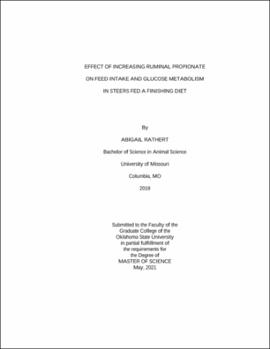| dc.description.abstract | Two experiments were conducted to investigate the effects of increased propionate supply to steers fed a feedlot finishing diet on dry matter intake, feeding behavior, glucose clearance rate, insulin response and hepatic gene expression. In experiment 1, Holstein steers (n = 15) were allocated by body weight to receive: 0 g/d Ca propionate (CON), 100 g/d (LOW), or 300 g/d (HIGH) with a finishing diet, ad libitum. Blood samples were collected on d 0, 7, and 21, and BW recorded on d 0, 14, and 28. A glucose tolerance test was conducted on d 14 and 28 of the trial. Liver biopsies were collected for gene expression. Blood samples were analyzed for glucose, lactate, NEFA and insulin concentrations. The CON treatment had greater (P < 0.01) DMI than LOW and HIGH. Glucose concentrations tended (P = 0.09) to be higher on d 21 than d 0 and 7. Nonesterified fatty acid concentrations were lower (P = 0.05) for CON than other treatments, and greater (P = 0.002) on d 0 than d 7 and 21. HIGH had greater insulin response than other treatments (P = 0.02). There was no treatment (P >/= 0.16) or day effect (P >/= 0.36) on glucose peak, plateau, or clearance rate. HIGH had greater (P = 0.05) hepatic expression of SLC16A1. In experiment 2, ruminally-cannulated Holstein steers (n = 6) were randomly assigned to the same treatments, describes in experiment 1, in a 3 x 6 Latin rectangle to be administered directly into the rumen. Weekly blood samples and body weight were collected and single glucose tolerance test and liver biopsies were conducted similarly to experiment 1. Additionally, rumen fluid samples were collected. All samples were analyzed the same as experiment 1. Dry matter intake, meal size, and number of meals per day was decreased (P < 0.049) in HIGH steers. There was no treatment effect (P >/= 0.13) on weekly body weight, plasma glucose, NEFA, lactate, or insulin, rumen fluid lactate or pH, or glucose clearance peak, plateau and rate. These data indicate that increased propionate may decrease DMI and alter feeding behavior. | |
